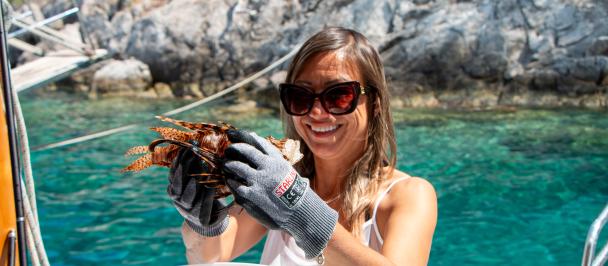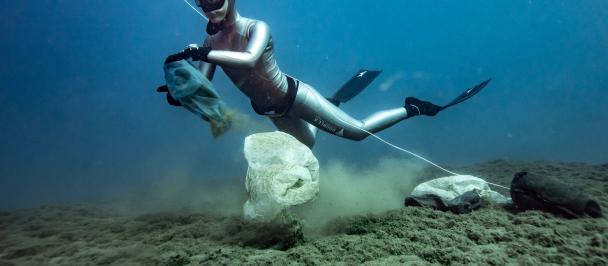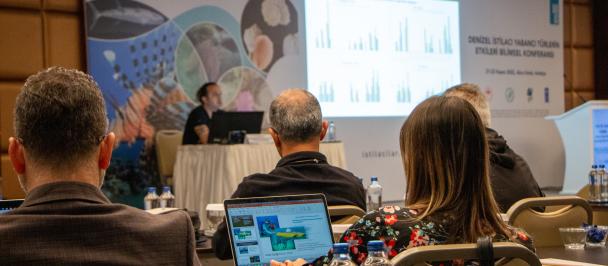Photo: Dr. Barış Özalp. Mediterranean Coral Cladocora caespitosa in Çanakkale Dardanos
Thanks to SGP Turkey supported efforts, first official declaration in Turkey for hard coral marine reserve of endangered Mediterranean Coral “Cladocora caespitosa” has been achieved
As a result of longterm efforts by a team at Çanakkale Onsekiz Mart University supported by GEF Small Grants Programme (SGP) Turkey, first hard coral marine reserve in Turkey was officially declared as a protected area where fishing activities around the reef site of Cladocora caespitosa have been prohibited.
Çanakkale Dardanos Cladocora Reef Site is known as the only largest reef habitat of the scleractinian coral C. caespitosa in the Turkish Straits System, consisting of the Çanakkale Strait, Istanbul Strait and Marmara Sea. It is located in the north-west of Turkey, hosting about 92 adult colonies, some of which are over 100 years old. The area which covers almost 2,000 m2 is highly important not only for the existence of the endangered coral but its paleobiological nature of some adult colonies.
Lead by an associate professor of marine science and head of the Scientific Diving Team (CASAE) at Çanakkale Onsekiz Mart University (COMU), Dr. Barış Özalp, scientific monitoring and research actions started in 2009. They have engaged in result-based conservation actions accordingly, in cooperation with the scientific diving team of COMU.
First investigations were aimed to reveal ecological and distributional characteristics of coral colonies in the Turkish Straits System. 200 stations in total between 0 - 60 m depth have been surveyed around the Çanakkale Strait (Dardanelles), where the main purpose was to raise the limited knowledge on Anthozoan species in Turkey.
In 2013, “Dardanelles Coral Reefs Protection”, also known as the first formal international project on coral fauna in Turkey, was developed and the GEF Small Grants Programme (SGP) Turkey which is hosted by UNDP Turkey supported the team to trigger the awareness raising and conservation actions including the process of official baseline of protected area application.
During the project, 4 buoys for biodiversity protection were located in the area (voluntarily without formal declaration), a scientific book, promotional materials, posters and brochures were published and distributed, seminars were organised besides the visits to almost 600 fishermen, coral reefs distribution, condition and damage parameters were specified and monitored via the scientific diving team of COMU, and in 7 spots 47 anchors in size of 1-4 m were removed. Also, the first official application to be declared as a protected area was done in cooperation with local NGOs and authorities.
As a result of longterm efforts, first hard coral marine reserve in Turkey was officially declared as a protected area where fishing activities, including anchoring and attaching the buoy, around the reef site of Cladocora caespitosa have been prohibited according to the formal announcement on 27 August 2021 (no: 2021/31) given by the Ministry of Agriculture and Forestry, General Directorate of Fisheries and Aquaculture.
Stating that in February 2021, the site “Dardanos Cladocora Reefs” was severely damaged by fishing nets, causing a complete breaking of certain adult colonies, some of which are over 100 years of age, Dr. Özalp says: “The situation was very chaotic in this limited area which represents a living refuge for 92 adult and 560 juvenile colonies in the Turkish Straits System. I believe that this one and only hard coral reserve in Turkey will breathe at last with this formal regulation. Since the area is very limited, no economical loss is expected for fishermen. We know that very recently, about 100,000 km2 was designated as marine protected area (MPA) in the Northern Scotland. So, when we compare the size of the site in Dardanos with other MPAs in the world, it is very limited in diameter. I hope this act on protection of the endangered coral C. caespitosa will also contribute to the marine protection policy and acts in Turkey.”
There are other coral habitats that were recently discovered; such as Hayirsiz Islet in Marmara Island, Tuzburnu in Bozcaada Island and off the coasts of Laz Bay, Gökçeada Island which require protection too. “If these sites may also be legalized as marine protected areas due to their unique habitats dominated by the endangered corals Cladocora caespitosa (cushion stony coral) and Savalia savaglia (gold coral), it is going to be beneficial for the sustainability of the marine life of Turkey,” says Özalp.

 Locations
Locations



